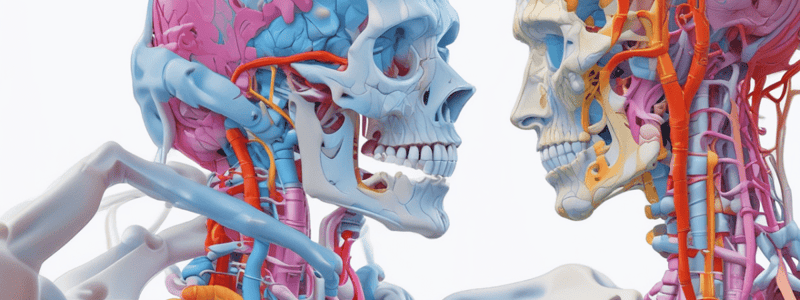Podcast
Questions and Answers
What is the primary difference between multislice CT (MSCT) and single slice CT (SSCT)?
What is the primary difference between multislice CT (MSCT) and single slice CT (SSCT)?
- Detector arrangement (correct)
- Image resolution
- Diagnostic techniques
- Scan time
How has the performance of CT been improved with the introduction of multislice CT (MSCT) according to the text?
How has the performance of CT been improved with the introduction of multislice CT (MSCT) according to the text?
- Reduced imaging range
- Decreased image resolution
- Increased radiation exposure
- Shortened scanning time (correct)
What effect does increasing the number of detector rows have on multislice CT (MSCT)?
What effect does increasing the number of detector rows have on multislice CT (MSCT)?
- Reduces scan length
- Increases the strain on the x-ray tube
- Increases the number of gantry rotations needed
- Decreases z-axis coverage slab thickness (correct)
How does multislice CT (MSCT) compare to single slice CT (SSCT) in terms of tomographic plane width?
How does multislice CT (MSCT) compare to single slice CT (SSCT) in terms of tomographic plane width?
What is the advantage of having multiple rows of CT detectors in multislice CT (MSCT)?
What is the advantage of having multiple rows of CT detectors in multislice CT (MSCT)?
How has the introduction of multislice CT (MSCT) affected the time required for 1 revolution of scanning?
How has the introduction of multislice CT (MSCT) affected the time required for 1 revolution of scanning?
What is the key difference between SSCT and MSCT in terms of slice thickness?
What is the key difference between SSCT and MSCT in terms of slice thickness?
What is the primary advantage of MSCT over SSCT in terms of imaging large volumes of tissue?
What is the primary advantage of MSCT over SSCT in terms of imaging large volumes of tissue?
What is the relationship between the number of detector rows and cone beam artifact severity in MSCT?
What is the relationship between the number of detector rows and cone beam artifact severity in MSCT?
What is the key advantage of MSCT over SSCT in terms of x-ray tube output limitations?
What is the key advantage of MSCT over SSCT in terms of x-ray tube output limitations?
What is the key difference between matrix detectors and adaptive array detectors in MSCT?
What is the key difference between matrix detectors and adaptive array detectors in MSCT?
What is the key difference between hybrid detectors and matrix detectors in MSCT?
What is the key difference between hybrid detectors and matrix detectors in MSCT?
What is the relationship between detector row number and slab thickness in MSCT?
What is the relationship between detector row number and slab thickness in MSCT?
How can the slice thickness be varied in MSCT scanners with multiple detector arrays?
How can the slice thickness be varied in MSCT scanners with multiple detector arrays?
What is the purpose of selectively activating or deactivating detector groups in MSCT?
What is the purpose of selectively activating or deactivating detector groups in MSCT?
What is the key difference between the x-ray beam configuration in SSCT and MSCT?
What is the key difference between the x-ray beam configuration in SSCT and MSCT?
What is the definition of detector pitch?
What is the definition of detector pitch?
What is the key advantage of Dual Source CT (DSCT) over single source CT?
What is the key advantage of Dual Source CT (DSCT) over single source CT?
What is the key difference between Dual Source Single Energy (DSSE) mode and Dual Source Dual Energy (DSDE) mode in DSCT?
What is the key difference between Dual Source Single Energy (DSSE) mode and Dual Source Dual Energy (DSDE) mode in DSCT?
What is the key advantage of Dual Energy CT (DECT) over conventional CT?
What is the key advantage of Dual Energy CT (DECT) over conventional CT?
What is the main principle behind the energy-dependent attenuation differences used in Dual Energy CT (DECT)?
What is the main principle behind the energy-dependent attenuation differences used in Dual Energy CT (DECT)?
What is the key difference between Dual Source Dual Energy (DSDE) mode and Single Source Dual Energy (SSDE) mode in DSCT?
What is the key difference between Dual Source Dual Energy (DSDE) mode and Single Source Dual Energy (SSDE) mode in DSCT?
What is the key advantage of Dual Energy CT (DECT) over traditional structural-only CT images?
What is the key advantage of Dual Energy CT (DECT) over traditional structural-only CT images?
What is the key principle behind the differentiation of materials in Dual Energy CT (DECT)?
What is the key principle behind the differentiation of materials in Dual Energy CT (DECT)?
What is the key difference between Dual Source CT (DSCT) and Single Source Dual Energy (SSDE) CT?
What is the key difference between Dual Source CT (DSCT) and Single Source Dual Energy (SSDE) CT?
Flashcards are hidden until you start studying


